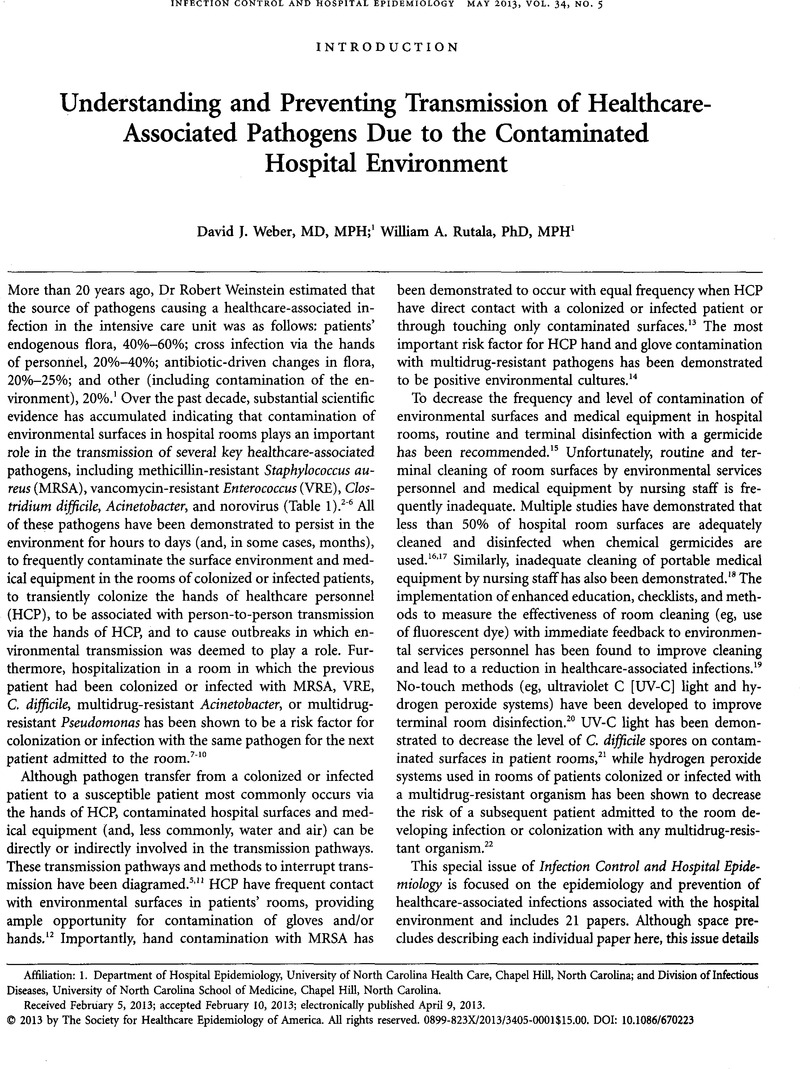Crossref Citations
This article has been cited by the following publications. This list is generated based on data provided by Crossref.
Harbarth, Stephan
Maiwald, Matthias
and
Dancer, Stephanie J.
2013.
The Environment and Healthcare-Acquired Infections: Why Accurate Reporting and Evaluation of Biological Plausibility Are Important.
Infection Control & Hospital Epidemiology,
Vol. 34,
Issue. 9,
p.
996.
Carling, Philip C.
Perkins, Jennifer
Ferguson, JoAnn
and
Thomasser, Anita
2014.
Evaluating a New Paradigm for Comparing Surface Disinfection in Clinical Practice.
Infection Control & Hospital Epidemiology,
Vol. 35,
Issue. 11,
p.
1349.
Calfee, David P.
Salgado, Cassandra D.
Milstone, Aaron M.
Harris, Anthony D.
Kuhar, David T.
Moody, Julia
Aureden, Kathy
Huang, Susan S.
Maragakis, Lisa L.
and
Yokoe, Deborah S.
2014.
Strategies to Prevent Methicillin-ResistantStaphylococcus aureusTransmission and Infection in Acute Care Hospitals: 2014 Update.
Infection Control & Hospital Epidemiology,
Vol. 35,
Issue. S2,
p.
S108.
Calfee, David P.
Salgado, Cassandra D.
Milstone, Aaron M.
Harris, Anthony D.
Kuhar, David T.
Moody, Julia
Aureden, Kathy
Huang, Susan S.
Maragakis, Lisa L.
and
Yokoe, Deborah S.
2014.
Strategies to Prevent Methicillin-ResistantStaphylococcus aureusTransmission and Infection in Acute Care Hospitals: 2014 Update.
Infection Control & Hospital Epidemiology,
Vol. 35,
Issue. 7,
p.
772.
Mann, Ethan E
Manna, Dipankar
Mettetal, Michael R
May, Rhea M
Dannemiller, Elisa M
Chung, Kenneth K
Brennan, Anthony B
and
Reddy, Shravanthi T
2014.
Surface micropattern limits bacterial contamination.
Antimicrobial Resistance and Infection Control,
Vol. 3,
Issue. 1,
Freeman, Joshua T
Nimmo, Jessica
Gregory, Eva
Tiong, Audrey
De Almeida, Mary
McAuliffe, Gary N
and
Roberts, Sally A
2014.
Predictors of hospital surface contamination with Extended-spectrum β-lactamase-producing Escherichia coli and Klebsiella pneumoniae: patient and organism factors.
Antimicrobial Resistance and Infection Control,
Vol. 3,
Issue. 1,
D’Arcy, N.
Cloutman-Green, E.
Lai, K. M.
Margaritis, D.
Klein, N.
and
Spratt, D. A.
2014.
Potential exposure of children to environmental microorganisms in indoor healthcare and educational settings.
Indoor and Built Environment,
Vol. 23,
Issue. 3,
p.
467.
Pulliam, John R.
2015.
Lower infection rates after introduction of a photocatalytic surface coating.
American Journal of Infection Control,
Vol. 43,
Issue. 2,
p.
180.
Livshiz-Riven, Ilana
Borer, Abraham
Nativ, Ronit
Eskira, Seada
and
Larson, Elaine
2015.
Relationship between shared patient care items and healthcare-associated infections: A systematic review.
International Journal of Nursing Studies,
Vol. 52,
Issue. 1,
p.
380.
Creech, C. Buddy
Al-Zubeidi, Duha N.
and
Fritz, Stephanie A.
2015.
Prevention of Recurrent Staphylococcal Skin Infections.
Infectious Disease Clinics of North America,
Vol. 29,
Issue. 3,
p.
429.
Lesho, Emil
Carling, Philip
Hosford, Eve
Ong, Ana
Snesrud, Erik
Sparks, Michael
Onmus-Leone, Fatma
Dzialowy, Nicole
Fraser, Susan
Kwak, Yoon
Miller, Sonia
Chukwuma, Uzo
Julius, Michael
McGann, Patrick
and
Clifford, Robert
2015.
Relationships Among Cleaning, Environmental DNA, and Healthcare-Associated Infections in a New Evidence-Based Design Hospital.
Infection Control & Hospital Epidemiology,
Vol. 36,
Issue. 10,
p.
1130.
Sassi, Hannah P.
Sifuentes, Laura Y.
Koenig, David W.
Nichols, Emmalee
Clark-Greuel, Jocelyn
Wong, Lung Fai
McGrath, Kevin
Gerba, Charles P.
and
Reynolds, Kelly A.
2015.
Control of the spread of viruses in a long-term care facility using hygiene protocols.
American Journal of Infection Control,
Vol. 43,
Issue. 7,
p.
702.
Simmons, Bryan P
and
Larson, Elaine L
2015.
Multiple drug resistant organisms in healthcare: the failure of contact precautions.
Journal of Infection Prevention,
Vol. 16,
Issue. 4,
p.
178.
Nagaraja, Aarathi
Visintainer, Paul
Haas, Janet P.
Menz, Jonathan
Wormser, Gary P.
and
Montecalvo, Marisa A.
2015.
Clostridium difficile infections before and during use of ultraviolet disinfection.
American Journal of Infection Control,
Vol. 43,
Issue. 9,
p.
940.
Rocha, Igor Vasconcelos
Ferraz, Patrick de Mélo
Farias, Thaísa Gabriela Silva de
and
Oliveira, Sibele Ribeiro de
2015.
Resistência de bactérias isoladas em equipamentos em unidade de terapia intensiva.
Acta Paulista de Enfermagem,
Vol. 28,
Issue. 5,
p.
433.
Roques, Christine
Al Mousa, Haifaa
Duse, Adriano
Gallagher, Rose
Koburger, Torsten
Lingaas, Egil
Petrosillo, Nicola
and
Škrlin, Jasenka
2015.
Consensus Statement: Patient Safety, Healthcare-Associated Infections and Hospital Environmental Surfaces.
Future Microbiology,
Vol. 10,
Issue. 10,
p.
1629.
Kim, Young Ah
Lee, Hyukmin
and
Lee, Kyungwon
2015.
Contamination of the Hospital Environmental by Pathogenic Bacteria and Infection Control.
Korean Journal of Nosocomial Infection Control,
Vol. 20,
Issue. 1,
p.
1.
Zarpellon, M.N.
Gales, A.C.
Sasaki, A.L.
Selhorst, G.J.
Menegucci, T.C.
Cardoso, C.L.
Garcia, L.B.
and
Tognim, M.C.B.
2015.
Survival of vancomycin-intermediate Staphylococcus aureus on hospital surfaces.
Journal of Hospital Infection,
Vol. 90,
Issue. 4,
p.
347.
Vianna, Pedro G.
Dale, Charles R.
Simmons, Sarah
Stibich, Mark
and
Licitra, Carmelo M.
2016.
Impact of pulsed xenon ultraviolet light on hospital-acquired infection rates in a community hospital.
American Journal of Infection Control,
Vol. 44,
Issue. 3,
p.
299.
Zenati, K.
Touati, A.
Bakour, S.
Sahli, F.
and
Rolain, J.M.
2016.
Characterization of NDM-1- and OXA-23-producing Acinetobacter baumannii isolates from inanimate surfaces in a hospital environment in Algeria.
Journal of Hospital Infection,
Vol. 92,
Issue. 1,
p.
19.



